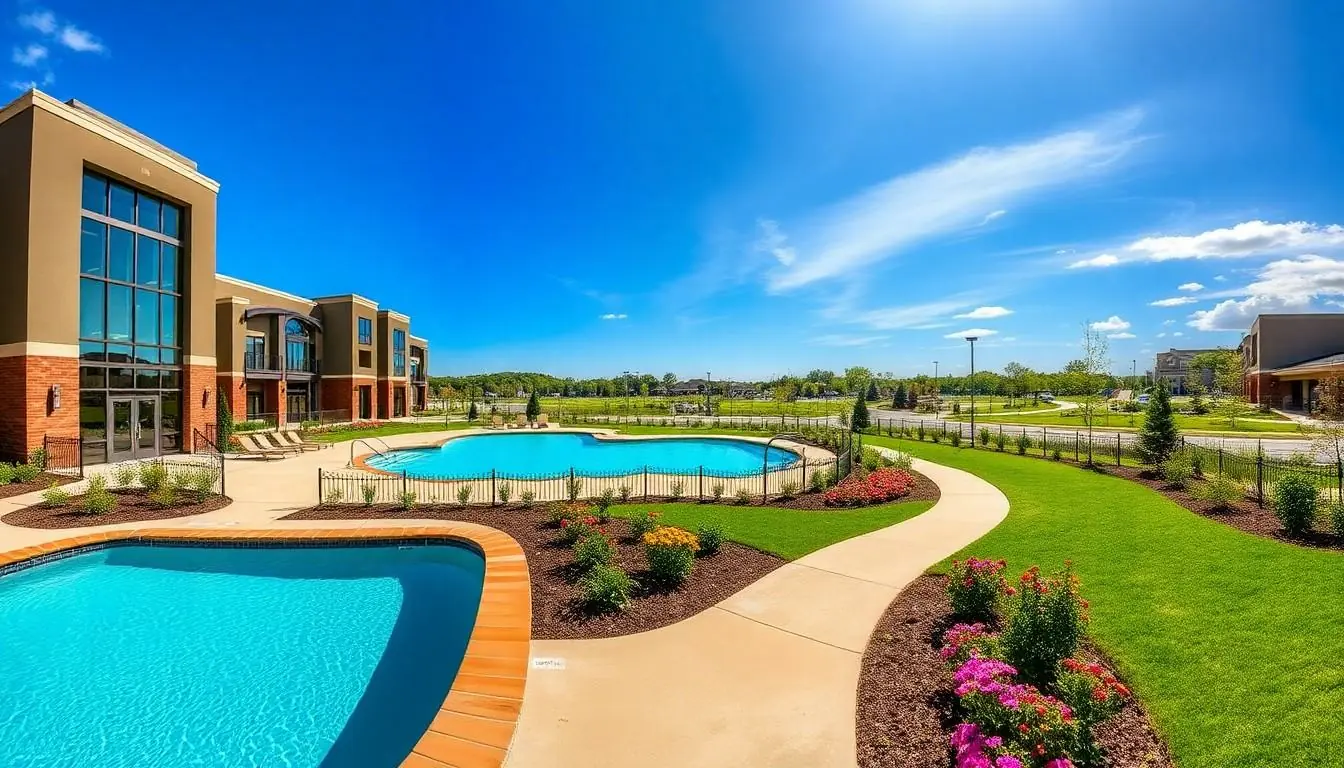In today’s fast-paced world, staying updated with live news is like having a front-row seat to the greatest show on Earth. Whether it’s breaking stories or the latest celebrity gossip, live news delivers the thrill of the moment straight to your screen. It’s like binge-watching your favorite series, but instead of plot twists, you get real-life drama unfolding right before your eyes.
Imagine sipping your morning coffee while catching up on the latest headlines or scrolling through your feed during lunch, chuckling at the unexpected turns of events. With live news, boredom is banished, and every notification feels like a VIP invitation to the action. Embrace the excitement and let live news keep you in the loop—because who wouldn’t want to be the one with the freshest scoop at the next dinner party?
Table of Contents
ToggleOverview of Live News
Live news serves as a vital source of information in today’s fast-paced society. Many individuals prefer real-time updates for their relevance and immediacy. This format of news reporting captures unfolding events as they happen, allowing audiences to experience events vicariously.
Engagement increases when viewers follow live coverage, as it adds a layer of excitement through interactive features. Audiences often engage with platforms that provide live updates via social media and dedicated news apps. With notifications and alerts, it’s easier for users to stay informed about major events.
Journalists play a crucial role in delivering accurate information quickly. They often relay real-time updates from different locations, ensuring that audiences receive diverse perspectives on an event. This immediacy strengthens public trust in these news sources.
In emergency situations, live news channels become invaluable. They provide crucial updates about natural disasters, health crises, and breaking news alerts, affecting community safety. Understanding shifts in information dissemination helps audiences navigate these dynamic discussions.
Following live news becomes part of daily routines for many. Commuters often catch up on news via smartphones during transit, while others choose radios or television screens at home. Engaging with live news fosters a sense of connection to the broader world.
Technological advancements revolutionize how audiences consume live news. High-definition streaming and immersive graphics enhance user experience, drawing viewers into the story. As engagement tools evolve, so does the audience’s experience with live news.
Importance of Live News

Live news serves as a crucial source of information, keeping individuals updated on current events as they unfold. Audiences benefit immensely from real-time insights that allow them to stay connected to the world around them.
Immediate Updates
Immediate updates offer quick access to crucial information. Timely reports during breaking news events inform the public about emergencies, disasters, or major political developments. Journalists deliver news within minutes of events happening, ensuring that viewers receive accurate and updated information swiftly. This immediacy allows individuals to make informed decisions based on the latest news. For example, during weather emergencies, real-time updates help communities respond appropriately to threats. The combination of speed and reliability fosters a sense of security among audiences.
Real-Time Engagement
Real-time engagement enhances the live news experience significantly. Viewers can participate in discussions through social media platforms, sharing their thoughts and reactions to unfolding stories. Interactive features, such as live polls or Q&A sessions, invite audiences to engage directly with journalists and presenters. Such opportunities create a shared experience among viewers, building a community around current events. Additionally, comments and feedback submitted during broadcasts allow for a diverse range of perspectives on important stories. This engagement not only enriches the viewing experience but also cultivates a sense of collective awareness and responsibility regarding global issues.
Major Platforms for Live News
Live news platforms provide diverse ways for audiences to access real-time information. They enhance engagement and foster connection to current events through various channels.
Television Networks
Television networks remain a primary source for live news. Major networks like CNN, BBC, and Fox News deliver round-the-clock coverage, ensuring audiences receive timely updates. Viewers can follow breaking news events, political debates, and special reports through traditional cable services. Local affiliates also play a crucial role in conveying community-specific information. High-definition broadcasts often incorporate expert commentary, enhancing the overall viewing experience. Interactive elements like scrolls and graphics help viewers digest relevant information quickly. With established reputations, these networks have built significant trust with audiences, becoming essential for staying informed in a fast-paced world.
Online Streaming Services
Online streaming services have reshaped how audiences consume live news. Platforms such as YouTube, Facebook Live, and Twitter offer real-time access to breaking news coverage. Users can watch live-streamed events, engage with content, and participate in discussions instantaneously. Many news organizations also broadcast live updates through their websites and apps, facilitating on-the-go access. Streaming services often utilize social media features, encouraging viewers to share thoughts and comments in real time. Flexibility in watching preferred news segments allows for a personalized experience tailored to individual interests. Overall, online streaming services complement traditional news sources, providing diverse ways to stay connected with the latest developments.
Challenges in Live News Reporting
Live news reporting faces several challenges that impact its overall effectiveness.
Accuracy and Credibility
Accuracy holds paramount importance in live news. Mistakes can lead to misinformation and public panic, undermining trust. Journalists must vet information quickly, often relying on social media reports that may not be verified. This rush to publish can result in inaccurate headlines that spread rapidly. Credibility hinges on providing well-sourced content, which requires teamwork among reporters, editors, and fact-checkers. The stakes amplify during breaking news, with organizations prioritizing rapid updates while striving for factual accuracy. Thus, ensuring credible reporting demands a delicate balance in urgent circumstances.
Time Constraints
Time constraints present another significant challenge for live news. Reporters often operate under immense pressure to deliver updates without delays. As events unfold, journalists must process information quickly, needing to decide what is relevant for viewers. This urgency can restrict the depth of analysis that news outlets offer, potentially leading to oversimplified narratives. Additionally, the immediacy required in reporting can cause reliance on initial impressions rather than comprehensive investigations. Resource allocation becomes essential, as teams must work efficiently to cover ongoing stories while maintaining high-quality standards.
Future of Live News
Live news continues to evolve rapidly, influenced by technological advancements and shifting audience behaviors. Trends indicate that the future promises even more immersive and engaging experiences.
Technological Innovations
New technologies transform how news is delivered and consumed. High-definition video and augmented reality are enhancing live broadcasts, making events feel more immediate and engaging. Additionally, artificial intelligence is streamlining news curation, offering personalized feeds tailored to individual user interests. Social media platforms are integrating live features, allowing users to interact and engage with real-time news events directly. Updates from citizen journalists can complement traditional reporting, fostering a broader perspective on current events. Continuous innovation in streaming services further shapes the landscape, providing audiences with flexible access to live news coverage anytime, anywhere.
Audience Trends
Changes in audience behavior significantly affect live news consumption. Younger demographics increasingly favor digital platforms over traditional television, seeking immediate access to updates via smartphones and tablets. This shift drives publishers to create content optimized for mobile use, emphasizing short, impactful segments. Engagement levels are rising, with viewers participating through live chats and social media discussions. User-generated content gains traction, making news more relatable and immediate. Interactive elements, such as real-time polls and Q&A sessions, foster community involvement, enriching the overall news experience. Audiences demand authenticity and transparency, prompting news providers to focus on credible reporting while maintaining engagement.
Staying updated on live news has transformed the way individuals connect with the world around them. It’s not just about information; it’s about engagement and community. The thrill of real-time updates and interactive features makes news consumption dynamic and immersive.
As technology advances the landscape of live news continues to evolve, offering audiences personalized experiences that cater to their interests. With platforms adapting to the preferences of younger demographics the future of live news looks promising.
This constant flow of information not only keeps boredom at bay but also fosters a sense of belonging in a rapidly changing world. By embracing live news individuals can stay informed and engaged while navigating the complexities of modern life.







